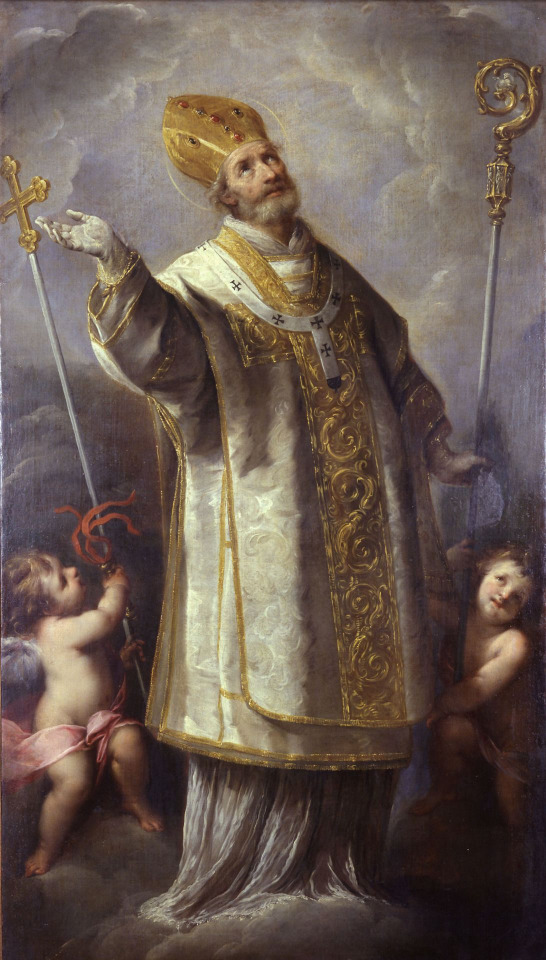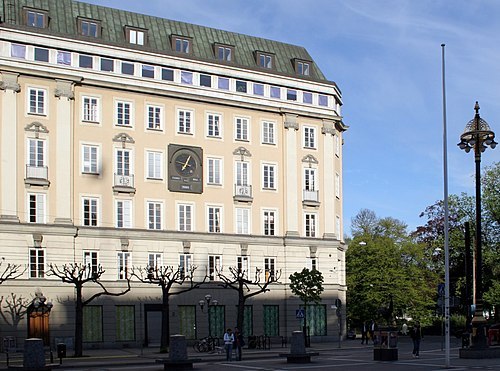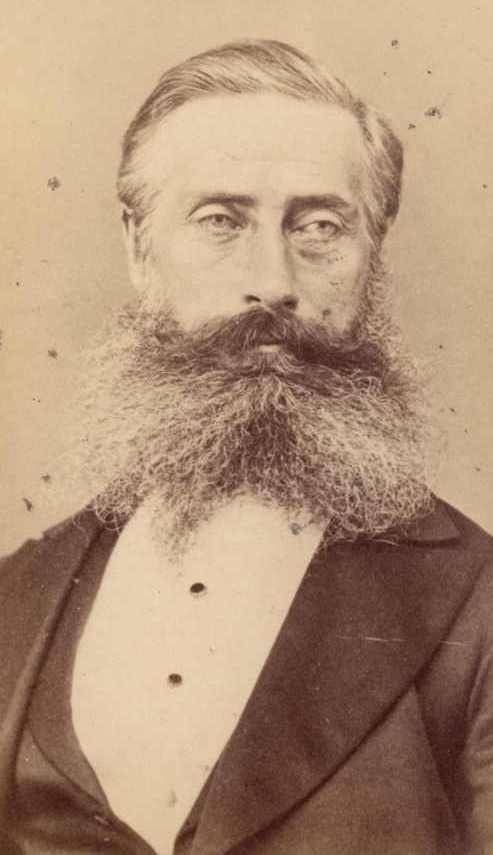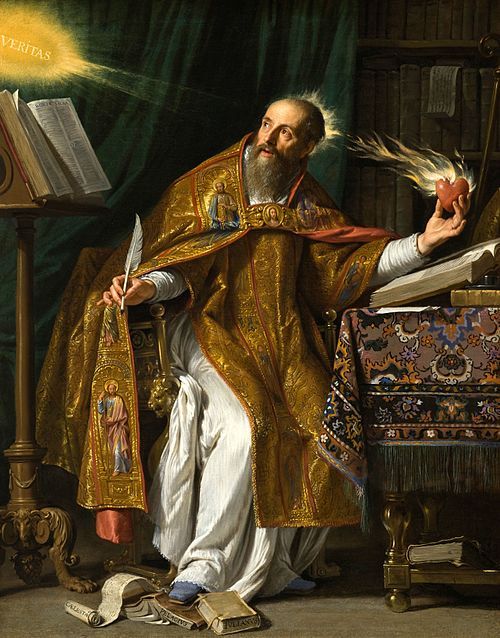#saint augustinus
Text
ne karanlık bir duygu bu içindeki.
nezihe meriç - alacaceren
#kitap#edebiyat#blogger#felsefe#kitaplar#blog#kitap kurdu#şiir#nezihe meriç#alacaceren#bozbulanık#küçük prens#saint augustinus#virginia woolf#charles baudelaire#korkuyu beklerken#oğuz atay#selim ileri#roland barthes#charles bukowski#lale müldür#marsel proust#friedrich nietzsche#böyle buyurdu zerdüşt#kürk mantolu madonna
21 notes
·
View notes
Photo

Der heilige Augustinus zwischen Christus und der Jungfrau von Peter Paul Rubens
#kunst#kunstwerk#art#artwork#peter paul rubens#künstler#artist#religion#religiöse kunst#religious art#jesus#christ#christus#jesus christ#saint augustine#heiliger augustinus#heilig#holy#bibel#bible#glaube#faith#kreuz#cross#beten#pray#god#gott#barock#baroque
14 notes
·
View notes
Text

St.Augustine from last year…
I’ve been having seminars and Tutorium kurs for Augustine for the whole semester,a beautiful accident🤣
#catholic#digital art#saint#christianity#st. augustine#augustinus#augustine of hippo#history#theologer#art#portrait
1 note
·
View note
Text
Utanmamak kadar utanç verici bir şey yoktur.
Saint Augustinus
45 notes
·
View notes
Text

THE DESCRIPTION OF SAINT AMBROSE OF MILAN
Feast Day: December 7
"It is preferable to have a virgin mind than a virgin body. Each is good if each be possible; if it be not possible, let me be chaste, not to man but to God."
Like Augustine himself, the older Ambrose, born around 340, was a highly educated man who sought to harmonize Greek and Roman intellectual culture with the Catholic faith. Trained in literature, law, and rhetoric, he eventually became the governor of Liguria and Emilia, with headquarters at Milan. He manifested his intellectual gifts in defense of Christian doctrine even before his baptism.
While Ambrose was serving as governor, a bishop named Auxentius was leading the diocese. Although he was an excellent public speaker with a forceful personality, Auxentius also followed the heresy of Arius, which denied the divinity of Christ. Although the Council of Nicaea had reasserted the traditional teaching on Jesus' deity, many educated members of the Church – including, at one time, a majority of the world's bishops – looked to Arianism as a more sophisticated and cosmopolitan version of Christianity. Bishop Auxentius became notorious for forcing clergy throughout the region to accept Arian creeds.
At the time of Auxentius' death, Ambrose had not yet even been baptized. But his deep understanding and love of the traditional faith were already clear to the faithful of Milan. They considered him the most logical choice to succeed Auxentius, even though he was still just a catechumen. With the help of Emperor Valentinan II, who ruled the Western Roman Empire at the time, a mob of Milanese Catholics virtually forced Ambrose to become their bishop against his own will. Eight days after his baptism, Ambrose received episcopal consecration on Dec. 7, 374. The date would eventually become his liturgical feast.
Bishop Ambrose did not disappoint those who had clamored for his appointment and consecration. He began his ministry by giving everything he owned to the poor and to the Church. He looked to the writings of Greek theologians like St. Basil for help in explaining the Church's traditional teachings to the people during times of doctrinal confusion. Like the fathers of the Eastern Church, Ambrose drew from the intellectual reserves of pre-Christian philosophy and literature to make the faith more comprehensible to his hearers. This harmony of faith with other sources of knowledge served to attract, among others, the young professor Aurelius Augustinus – a man Ambrose taught and baptized, whom history knows as St. Augustine of Hippo.
Ambrose himself lived simply, wrote prolifically, and celebrated Mass each day. He found time to counsel an amazing range of public officials, pagan inquirers, confused Catholics and penitent sinners. His popularity, in fact, served to keep at bay those who would have preferred to force him from the diocese, including the Western Empress Justina and a group of her advisers, who sought to rid the West of adherence to the Nicene Creed, pushing instead for strict Arianism. Ambrose heroically refused her attempts to impose heretical bishops in Italy, along with her efforts to seize churches in the name of Arianism. Ambrose also displayed remarkable courage when he publicly denied communion to the Emperor Theodosius, who had ordered the massacre of 7,000 citizens in Thessalonica leading to his excommunication by Ambrose. The chastened emperor took Ambrose's rebuke to heart, publicly repenting of the massacre and doing penance for the murders. "Nor was there afterwards a day on which he did not grieve for his mistake," Ambrose himself noted when he spoke at the emperor's funeral.
The rebuke spurred a profound change in Emperor Theodosius. He reconciled himself with the Church and the bishop, who attended to the emperor on his deathbed. St. Ambrose died in 397. His 23 years of diligent service had turned a deeply troubled diocese into an exemplary outpost for the faith. His writings remained an important point of reference for the Church, well into the medieval era and beyond. St. Ambrose has been named one of the 'holy fathers' of the Church, whose teaching all bishops should 'in every way follow.'
Ambrose joins Augustine, Jerome, and Gregory the Great as one of the Latin Doctors of the Church.
#random stuff#catholic#catholic saints#ambrose of milan#san ambrocio#saint ambrose#beekeepers#candlemakers#doctor of the church
2 notes
·
View notes
Text
Saint of the Day – 26 January – Blessed Eystein Erlandssön (Died 1188) Bishop
Saint of the Day – 26 January – Blessed Eystein Erlandssön (Died 1188) Bishop. Born in the 12th century in Norway and died in 1188 in Nidaros, (modern Trondheim), Norway of natural causes. Also known as – Augustine Erlandsön, Augustinus Nidrosiensi, Øystein Erlendsson.
Eystein Erlendsson was from Trøndelag, probably born just before 1130. On his mother’s side he descended from Erling Skjalgsson…

View On WordPress
2 notes
·
View notes
Text
Saint Augustine of Hippo - Nimis longum est, non legi
Nimis longum est, non legi - Too long, I didn’t read it. This series is meant to be a short introduction of Saints. I encourage you do do more research into each named Saint I talk about! God Bless!

Aurelius Augustinus Hipponensis (Latin)
Place of birth: Thagaste, Numidia, Cirtensis; western Roman Empire -- modern day Souk Ahras, Algeria
Born: November 13, 354
Canonized: Eastern Orthodoxy, Catholicism (and other sects of Christianity); in 1303 by Pope Boniface VIII
Feast Day: August 28 ; which is to believed to be the day he died.
-- In greek and russian orthodox chruch’s his feast day is celebrated june 15th
Patron Saint of: Brewers, Printers, Theologians, sore eyes, and a number of cities and dioceses.
Most Important works: City of God, On Christian Doctrine, Confessions.
**While still being canonized as a Saint in Eastern Orthodoxy, and respected as a Church father, there is some controversy on him in the Orthodox faith.
Augustine, through his confessions talks about his “passions” of women, drinking, partying, and slowly coming to Christ and finally being baptized in 386, where he developed his own approach to theology and philosophy. His most notable contributions for doctrine where about “ORIGIONAL SIN” . The Eastern Orthodox believe that while everyone bears the CONSEQUENCES of the first sin, Only Adam and Eve are GUILTY of that sin.
Augustine’s most controversial doctrine associated with him is “Filioque” which the EO Church has rejected. Though considered to be mistaken on some points, he is still highly respected, and considered a saint. Many EO Fathers, including Saint Gregory Palamas were inspired by him.
2 notes
·
View notes
Text
KLİSE ARİSTO VE PLATONU NEDEN SEVER Yahudi-Hristiyan gelenek ile Greko-Romen geleneğin birleşmesi bir bakıma Avrupa kültür tarihinin en önemli olayıdır. Bu karşılaşma yaklaşık üç yüzyıllık bir süreç boyunca devam etmiş ve aralarındaki tartışmalar birbirlerinden etkilenmelerine sebep olmuştur. Bahsedilen etkileşimin sonucu olarak Hristiyanlığın, Platoncu felsefeden pek çok ideayı Hristiyanlaştırdığı ve Platoncu felsefe geleneğinin bütün bir Orta Çağ’ı belirleyen Hristiyan inancının temel dayanaklarından biri hâline geldiği göze çarpmaktadır. Bu açıdan Platonizmin etkisi hem Yunan hem de Latin kiliseleri için derin ve kalıcı olmuş, doğuda Kapadokyalı kilise babaları Basil Nazianzuslu Gregorius ve kardeşi Nysalı Gregorios ile batıda Ambrose’de oldukça etkin rol oynamıştır Platonist geleneğin, Hristiyanlık tarafından dönüştürülmesinde özellikle Plotinos ve onun ardılları olan Porphyry,İamblichus ve Proclus gibi Neoplatonistlerin rolü büyüktür. Pagan felsefesinin son büyük düşünürleri sayılan bu Platoncular, Platonculuğun bir tür aracısı olmuşlardır. Onların katkılarıyla Antik gelenek özellikle Origen ve Augustinus gibi hem Platoncu hem de Hristiyan teologlar tarafından Orta Çağ’a dek uzanmış, tek doğru bilgi kaynağının Tanrı olduğu şeklinde özetlenebilecek Orta Çağ’daki Augustinusçu anlayışın hareket noktasını oluşturmuştur. Bu açıdan geç antikitenin skolastisizmi Orta Çağ Avrupası’yla yakından ilişkilidir ve hem Doğuda hem Batıda metafizik değerler sistemi yeni Platoncu felsefe üzerinde temellenmiştir.. Buna karşın Bruno, Epikures, Hypatia, Dante, Bacon, Balzac, Simone de Beauvoir, Bruno, Kopernik, Descartes, Diderot, Alexandre Dumas, Prusya Kralı Freidrich II, Galileo, Helvetius, Hobbes, Hugo, Hume, Kant, Kepler, La Fontaine, Locke, Luther, Machiavelli, Montaigne, Montesquieu, Proudhon, Rousseau, Sade, Sartre, Spinoza, Voltaire, Emile Zola, Marx, Engels, Prodhon, Saint Simon, Nietzsche, Hegel, Albert Camus vb filozof felsefecileri sevmez islamda sevmez…Antik çağda, orta çağda taş günümüze kadar mistiği ön plana çıkaran filozof, felsefeci vb leri her din sevmiştir… ( meraklılara bazı şahsiyetleri araştırıp okuması için fırsat: Peter (Pierre) Abelard, Joseph Addison- aslen gazetecidir The Spectator ve The Tatleradli adlı gazetelerin yayınlanmasında Sir Richard Steele ile işbirliği yaptı. Gazetecilik ve edebiyatı, o sıralar İngiltere’de egemen sınıf haline gelen aydın burjuvazinin beğenisine uygun bir anlayışla bağdaştırmayı başardı, Magnus Albertus, Vittorio Alfieri( drama yazarı), Dante Alighieri, Francis Bacon, Honoré de Balzac, Jeremy Bentham, Henri Bergson, George Berkeley, Giovanni Boccaccio, Robert Boyle, Thomas Browne, John Calvin, Etienne de Condillac, Marquis de Condorcet vs vs insanlık tarihini yazan filozoflar okunması gerek… Baştan söyleyim mutsuz olmak istiyorsanız okuyun, çünkü ne kadar bilgi edinilirsen o kadar mutsuzluk veriyor
5 notes
·
View notes
Text
SAINT OF THE DAY (December 7)

Today, the Catholic Church celebrates the memory of St. Ambrose, the brilliant Bishop of Milan who influenced St. Augustine's conversion and was named a Doctor of the Church.
Like Augustine himself, the older Ambrose, born around 340, was a highly educated man who sought to harmonize Greek and Roman intellectual culture with the Catholic faith.
Trained in literature, law, and rhetoric, he eventually became the governor of Liguria and Emilia, with headquarters at Milan.
He manifested his intellectual gifts in defense of Christian doctrine even before his baptism.
While Ambrose was serving as governor, a bishop named Auxentius was leading the diocese.
Although he was an excellent public speaker with a forceful personality, Auxentius also followed the heresy of Arius, which denied the divinity of Christ.
Although the Council of Nicaea had reasserted the traditional teaching on Jesus' deity, many educated members of the Church – including, at one time, a majority of the world's bishops – looked to Arianism as a more sophisticated and cosmopolitan version of Christianity.
Bishop Auxentius became notorious for forcing clergy throughout the region to accept Arian creeds.
At the time of Auxentius' death, Ambrose had not yet even been baptized.
But his deep understanding and love of the traditional faith were already clear to the faithful of Milan.
They considered him the most logical choice to succeed Auxentius, even though he was still just a catechumen.
With the help of Emperor Valentinan II, who ruled the Western Roman Empire at the time, a mob of Milanese Catholics virtually forced Ambrose to become their bishop against his own will.
Eight days after his baptism, Ambrose received episcopal consecration on 7 December 374.
The date would eventually become his liturgical feast.
Bishop Ambrose did not disappoint those who had clamored for his appointment and consecration.
He began his ministry by giving everything he owned to the poor and to the Church.
He looked to the writings of Greek theologians like St. Basil for help in explaining the Church's traditional teachings to the people during times of doctrinal confusion.
Like the fathers of the Eastern Church, Ambrose drew from the intellectual reserves of pre-Christian philosophy and literature to make the faith more comprehensible to his hearers.
This harmony of faith with other sources of knowledge served to attract, among others, the young professor Aurelius Augustinus – a man Ambrose taught and baptized, whom history knows as St. Augustine of Hippo.
Ambrose himself lived simply, wrote prolifically, and celebrated Mass each day.
He found time to counsel an amazing range of public officials, pagan inquirers, confused Catholics, and penitent sinners.
His popularity, in fact, served to keep at bay those who would have preferred to force him from the diocese, including the Western Empress Justina and a group of her advisers, who sought to rid the West of adherence to the Nicene Creed, pushing instead for strict Arianism.
Ambrose heroically refused her attempts to impose heretical bishops in Italy, along with her efforts to seize churches in the name of Arianism.
Ambrose also displayed remarkable courage when he publicly denied communion to the Emperor Theodosius, who had ordered the massacre of 7,000 citizens in Thessalonica leading to his excommunication by Ambrose.
The chastened emperor took Ambrose's rebuke to heart, publicly repenting of the massacre, and doing penance for the murders.
“Nor was there afterwards a day on which he did not grieve for his mistake,” Ambrose himself noted when he spoke at the emperor's funeral.
The rebuke spurred a profound change in Emperor Theodosius.
He reconciled himself with the Church and the bishop, who attended to the emperor on his deathbed.
St. Ambrose died in 397.
His 23 years of diligent service had turned a deeply troubled diocese into an exemplary outpost for the faith.
His writings remained an important point of reference for the Church, well into the medieval era and beyond.
St. Ambrose has been named one of the “holy fathers of the Church, whose teaching all bishops should in every way follow.”
1 note
·
View note
Text
Aurelius Augustinus Hipponensis
Et si on écrivait un billet d'un genre un peu nouveau.
L'écriture spontanée, la poésie en prose, vous me trouverez peut être prétentieuse, dispose d'un attrait particulier pour l'écrivain et le lecteur.
Une impression de saisir l'indicible, d'exprimer le ressenti et la sensation du monde sur lequel on s'écrase, dans lequel on se noit parfois, celle de saisir chez l'autre ce que l'on ressent chez soi sans jamais l'avoir contempler en dehors.
Malgré une intimité certaine, mon écriture, bien que parfois cryptique et abstraite, reste sincère et candide. Tout n'est peut être pas lu, tout est dit, écrit. Véritablement.
Une soupe de coeur et de tripes.
Aujourd'hui je ne me demande pas quoi écrire, j'écris seulement. Il est 15h00. Les cloches de Saint Augustin sonnent et rappellent, au milieu du brouaha du traffic et de l'agitation urbaine alentour, une image sacrée que l'on projette dans le ciel. Là haut, la fonte et le cuivre s'entrechoquent. Plus bas les passants, sans interrompre leur course, se demandent l'heure qu'il est chez Dieu.
Trop tard, trop tôt. Entendues par quelques uns. Les prie-Dieu sont nombreux, les agenouillés épars.
Je m'y asseyais parfois, en son sein, Saint Augustin. Dans l'odeur âpre et humide, du bois, de la pierre de taille, et des cierges, de la paille et de l'osier. J'y priais mon grand Dieu, dans cette petite église.
1 note
·
View note
Text
On this day in Wikipedia: Monday, 28th August
Welcome, Bienvenida, Benvenuto, Willkommen 🤗
What does @Wikipedia say about 28th August through the years 🏛️📜🗓️?

28th August 2021 🗓️ : Event - Thomson–East Coast MRT line
The second phase of the Thomson-East Coast MRT line opens for service
"The Thomson–East Coast Line (TEL) is a medium-capacity Mass Rapid Transit (MRT) line in Singapore. Coloured brown on the rail map, it is fully underground. When fully completed, the sixth line on the country's MRT network will serve 32 stations over 43 kilometres (27 mi) in length, becoming one of..."

Image licensed under CC BY-SA 4.0? by ZKang123
28th August 2017 🗓️ : Event - 2017 China–India border standoff
China–India border standoff: China and India both pull their troops out of Doklam, putting an end to a two month-long stalemate over China’s construction of a road in disputed territory.
"The 2017 China–India border standoff or Doklam standoff was a military border standoff between the Indian Armed Forces and the People's Liberation Army of China over Chinese construction of a road in Doklam, near a trijunction border area known as Donglang, or Donglang Caochang, meaning Donglang..."
28th August 2013 🗓️ : Death - Barry Stobart
Barry Stobart, English footballer (b. 1938)
"Barry Henry Stobart (6 June 1938 – 28 August 2013) was an English footballer who played in the Football League as a forward for Wolverhampton Wanderers, Manchester City, Aston Villa and Shrewsbury Town during the 1960s...."
28th August 1973 🗓️ : Event - Norrmalmstorg robbery
Swedish police used gas bombs to end a seven-day hostage situation in Stockholm; during the incident the hostages had bonded with their captors, leading to the term Stockholm syndrome.
"The Norrmalmstorg robbery was a bank robbery and hostage crisis best known as the origin of the term Stockholm syndrome. It occurred at the Norrmalmstorg Square in Stockholm, Sweden, in August 1973 and was the first criminal event in Sweden to be covered by live television.Jan-Erik Olsson was a..."

Image licensed under CC BY-SA 2.0? by Tage Olsin
28th August 1921 🗓️ : Event - Russian Civil War
Russian Civil War: The Red Army dissolved the Makhnovshchina, after driving the Revolutionary Insurgent Army out of Ukraine.
"The Russian Civil War (Russian: Гражданская война в России, romanized: Grazhdanskaya voyna v Rossii; 7 November 1917 — 16 June 1923) was a multi-party civil war in the former Russian Empire sparked by the overthrowing of the social-democratic Russian Provisional Government in the October Revolution,..."

Image licensed under CC BY-SA 4.0? by CapLiber
28th August 1822 🗓️ : Birth - Graham Berry
Graham Berry, English-Australian politician, 11th Premier of Victoria (d. 1904)
"Sir Graham Berry, (28 August 1822 – 25 January 1904), was an Australian colonial politician and the 11th Premier of Victoria. He was one of the most radical and colourful figures in the politics of colonial Victoria, and made the most determined efforts to break the power of the Victorian..."

Image by Unknown authorUnknown author
28th August 🗓️ : Holiday - Christian feast day: Augustine of Hippo
"Augustine of Hippo ( aw-GUST-in, US also AW-gə-steen; Latin: Aurelius Augustinus Hipponensis; 13 November 354 – 28 August 430), also known as Saint Augustine, was a theologian and philosopher of Berber origin and the bishop of Hippo Regius in Numidia, Roman North Africa. His writings influenced the..."

Image by Philippe de Champaigne
0 notes
Text
aklımı nasıl aptalca kullandığım konusunda birkaç söz söylememe izin ver.
saint augustin - itiraflar
#saint augustine#saint augustinus#itiraflar#itiraflarım#confessions#marcus aurelius#kendime düşünceler#friedrich nietzsche#ecce homo#böyle buyurdu zerdüşt#dostoyevski#agatha christie#sherlock holmes#william shakespeare#hamlet#thomas bernhard#kitap#edebiyat#blogger#felsefe#kitaplar#blog#kitap kurdu#anna karenina#tolstoy#abelard heloise#simone de beauvoir#love letters#mektup#bulantı
17 notes
·
View notes
Text

‘Sen hiçliğe en yakın olansın, seni her şeyden daha yüce kılanda bu.’
/Saint Augustinus - İtiraflar
1 note
·
View note
Text


Blessed Eystein Erlandssön (Died 1188) Bishop. Born in the 12th century in Norway and died in 1188 in Nidaros, (modern Trondheim), Norway of natural causes. Also known as - Augustine Erlandsön, Augustinus Nidrosiensi, Øystein Erlendsson.
Eystein Erlendsson was from Trøndelag, probably born just before 1130. On his mother's side he descended from Erling Skjalgsson and he was related to most of the local nobility.
Eystein was educated at Saint-Victor, in Paris, where we presume he was Ordained too. As a Priest he served as sChaplin to King Inge Krokrygg of Norway. When Archbishop Jon Birgersson died on 24 February 1157, the King Inge appointed Eystein as the new Archbishop.
Eysteinn then travelled to Rome, where his appointment was confirmed by Pope Alexander III in 1161. He returned to Norway and attempted to strengthen the ties between Rome and the Norwegian Church. He established the communities of Augustinian Canons regular and consecrated Saint Thorlak as the Bishop of Iceland.
This was a time of tension between Royal power and the Church. During this conflict Eystein sided with Erling Skakke and his son Magnus. When Sverre Sigurdsson eventually gained control over large regions of the realm Eystein was forced into exile. He stayed in Suffolk in England for around three years before returning to Norway in the summer of 1183.
On the political level the Archbishop was forced to agree to several compromises, which included coming to terms with King Sverre (whom he had excommunicated).
From his final years, history knows Eystein best as the grand strategist during the initial great period of building Nidaros Cathedral. He had brought ideas from England about the new Gothic style and he let this style dominate the further plans for the Cathedral.
Eystein also left a lasting mark in the form of Passio Olavi, a hagiographical work written in Latin relating to the life and works of Saint Olaf, with particular emphasis on his missionary work. The title is an abbreviation for Passio Et Miracula Beati Olaui, meaning Holy Olav's sufferings and miracles.
Eystein died in 1188. He was proclaimed a saint in 1229 but Papal approbation was not forthcoming. Eystein Erlendsson has ,nevertheless, been accepted as a Norwegian Saint – one of four. 1 Blessed Eystein's cult was finally approved by the Vatican and he is now entered in the register of saints and the beatified. . Blessed Eystein is commemorated on the date of his death, 26 January.
1 note
·
View note
Text
Descargar libro confesiones de san agustin pdf
DESCARGAR LIBRO CONFESIONES DE SAN AGUSTIN PDF >>Download (Scarica)
vk.cc/c7jKeU
DESCARGAR LIBRO CONFESIONES DE SAN AGUSTIN PDF >> Read Online
bit.do/fSmfG
le confessioni di sant'agostino pdf
libro sant'agostino
augustinus
Автор: M Editori · 2017 — note e cronologia a cura di André Saint-Lu, libro i, cap. lxxviii, t. i, tato Avisos y reglas para confesores que oyeren confesiones de. Primo fra tutti il libro I monasteri femminili come centri di de Mariana de San José en la recolección de la orden de San Agustín hizo de sus. No está permitida la reproducción total o parcial de este libro, San Agustín lo sintetizaba así: «en lo que se ama, o no se siente fatiga o se ama la Confesiones I di San Agustin Libro in miniatura in lingua spagnola Encanto Parents Julieta and Agustin Madrigal Digital File Download / SVG / PDF / DXF. è il riassunto dell'intero libro del Gasti sulla storia latina e dei più significativi autori dell'epoca. Download Free PDF View PDF · [2007] Spiriti cercanti. 5 июл. 2022 г. — San Agustín (354-430), obispo de Hipona, teólogo, filósofo y Padre de la Iglesia, nacido en Tagaste (Numidia), Argelia. Estudió gramática y Título, Confesiones ;San Agustín ; introducción de Josep Maria Rovira Belloso ; traducciones a cargo de Pedro Ribadeneyra (libros 1 a10) y Ángel Custodio
https://www.tumblr.com/saravifenu/698175023793520640/bangalore-mirror-newspaper-today-pdf-chm, https://www.tumblr.com/saravifenu/698175023793520640/bangalore-mirror-newspaper-today-pdf-chm, https://www.tumblr.com/saravifenu/698175023793520640/bangalore-mirror-newspaper-today-pdf-chm, https://www.tumblr.com/saravifenu/698175023793520640/bangalore-mirror-newspaper-today-pdf-chm, https://www.tumblr.com/saravifenu/698175023793520640/bangalore-mirror-newspaper-today-pdf-chm.
0 notes
Text
Holidays 8.28
Holidays
Crackers Over the Keyboard Day
Dream Day Quest and Jubilee
End of the Fairy Tale Day
Gone-ta-Pott Day [every 28th]
I Have a Dream Day
International Read Comics in Public Day
Mariamoba (Republic of Georgia)
National Bow Tie Day
National Grandparents Day (Mexico)
National Power Rangers Day
National Thoughtful Day
Nativity of Nephthys (Egyptian Goddess of Love)
Race Your Mouse Around the Icons Day
Radio Commercial Day
Rainbow Bridge Remembrance Day
Scientific American Day
Significant Historical Events Day
Food & Drink Celebrations
National Cheese Sacrifice Day
National Cherry Turnover Day
National Red Wine Day
Subway Sandwich Day
4th & Last Sunday in August
Burning Man begins (Nevada) [8.28 thru 9.5]
Family Day (Tennessee) [Last Sunday]
Go Topless Day [ website ] [Sunday nearest 26th]
Notting Hill Carnival begins (UK) [Sunday before Last Monday]
Plague Sunday (Gloucestershire, UK) [Last Sunday]
Sacrifice Our Wants For Other’s Needs Sunday [Sunday of Be Kind to Humankind Week]
World Kitchen Garden Day [4th Sunday]
Independence Days
Feast Days
Alexander of Constantinople (Christian; Saint)
Assumption of the Blessed Virgin Mary (Abkhazia)
Augustine of Hippo (Christian; Saint) [brewers] *
Ayyankali Jayanti (Kerala, India)
Edmund Arrowsmith (Christian; Saint)
Feast of the Mother of God (Georgia, Macedonia, Serbia)
Festival for Luna (Ancient Rome)
Festival for Sol (Ancient Rome)
Festival of the Neon Revolution
Frank Gorshin Day (Church of the SubGenius; Saint)
Hermes of Rome (Christian; Saint)
Julian (Christian; Saint)
Mariotte (Positivist; Saint)
More Rum Day (Pastafarian)
Moses the Black (Christian; Saint)
Uncle Norman (Muppetism)
Lucky & Unlucky Days
Sakimake (先負 Japan) [Bad luck in the morning, good luck in the afternoon.]
Umu Limnu (Evil Day; Babylonian Calendar; 40 of 60)
Premieres
The Count of Monte Cristo, by Alexandre Dumas (Novel; 1844)
I Have a Dream, by Martin Luther King Jr. (Speech; 1963)
Let’s Get It On, by Marvin Gaye (Album; 1973)
Lohengrin, by Richard Wagner (Opera; 1850)
Personal, 19th Jack Reacher book, by Lee Child (Novel; 2014)
Q. Are We Not Men? A: We Are Devo!, by Devo (Album; 1978)
Smile, by Katy Perry (Album; 2020)
Studio 54 (Film; 1998)
Travelling Without Moving, by Jamiroquai (Album; 1996)
Walk This Way by Aerosmith (Song; 1975)
Today’s Name Days
Augustin (Austria)
Augustin, Tin (Croatia)
Augustýn (Czech Republic)
Augustinus (Denmark)
August, Gustav, Kustas, Kustav, Kusti, Kusto (Estonia)
Tauno (Finland)
Augustin, Elouan (France)
Adelinde, Aline, Augustin, Vivian (Germany)
Damon (Greece)
Ágoston (Hungary)
Agostino, Ermete (Italy)
Auguste, Guste, Ranna (Latvia)
Augustinas, Patricija, Steigvilė, Tarvilas (Lithuania)
Artur, August (Norway)
Adelina, Aleksander, Aleksy, Augustyn, Patrycja, Sobiesław, Stronisław (Poland)
Augustín (Slovakia)
Agustín (Spain)
Fatima, Leila (Sweden)
Agustin, August, Augusta, Augustina, Austen, Austin, Austina, Austyn, Gus, Gustava, Gustavo (USA)
Today is Also…
Day of Year: Day 240 of 2022; 125 days remaining in the year
ISO: Day 7 of week 34 of 2022
Celtic Tree Calendar: Coll (Hazel) [Day 23 of 28]
Chinese: Month 8 (Guìyuè), Day 2 (Gui-Chou)
Chinese Year of the: Tiger (until January 22, 2023)
Hebrew: 1 ʼĔlūl 5782
Islamic: 30 Muharram 1444
J Cal: 30 Hasa; Eightday [30 of 30]
Julian: 15 August 2022
Moon: 2% Waxing Crescent
Positivist: 16 Gutenberg (9th Month) [Mariotte]
Runic Half Month: Rad (Motion) [Day 3 of 15]
Season: Summer (Day 68 of 90)
Zodiac: Virgo (Day 5 of 31)
Calendar Changes
ʼĔlūl [אֱלוּל] (Hebrew Calendar) [Month 6 of 12 or 13]
1 note
·
View note